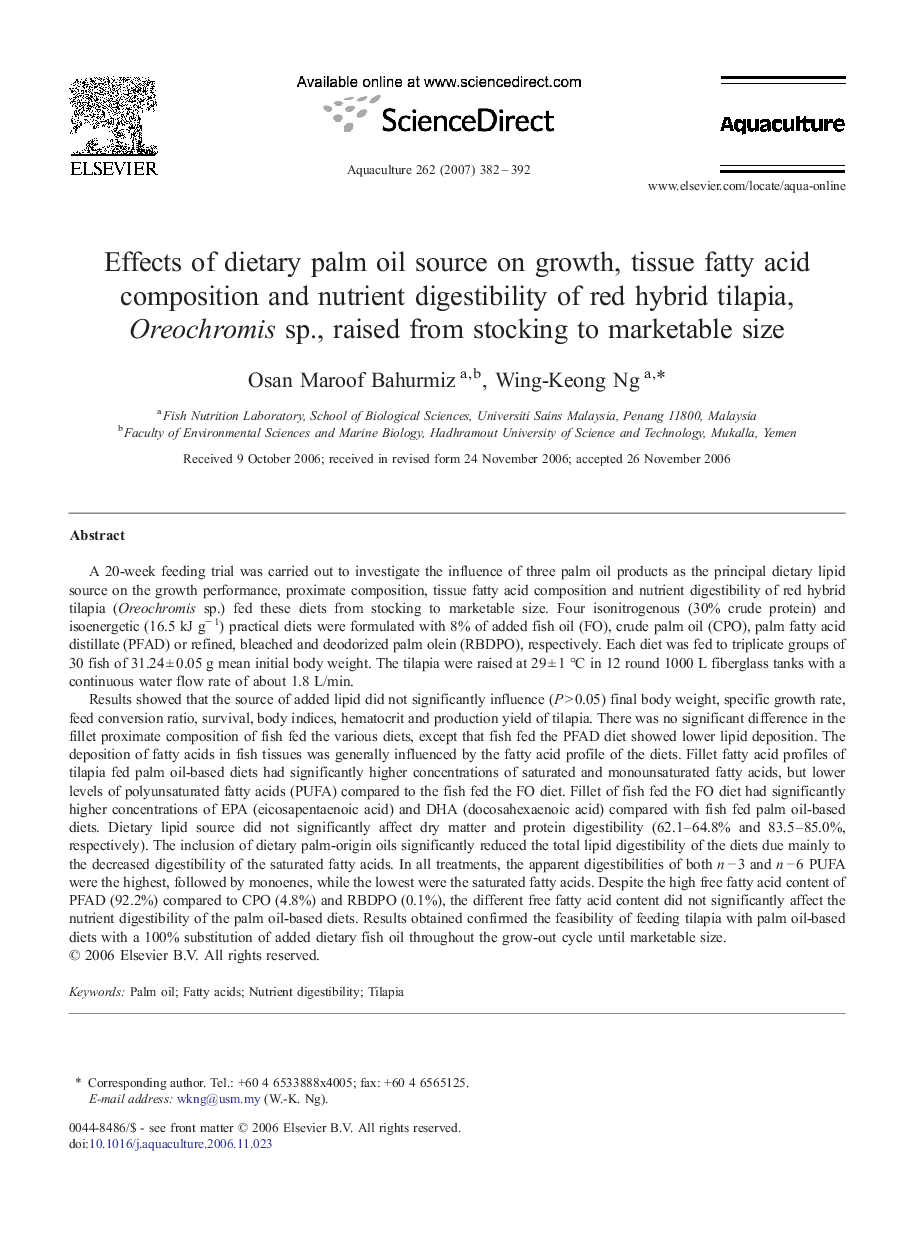| کد مقاله | کد نشریه | سال انتشار | مقاله انگلیسی | نسخه تمام متن |
|---|---|---|---|---|
| 2425333 | 1552980 | 2007 | 11 صفحه PDF | دانلود رایگان |

A 20-week feeding trial was carried out to investigate the influence of three palm oil products as the principal dietary lipid source on the growth performance, proximate composition, tissue fatty acid composition and nutrient digestibility of red hybrid tilapia (Oreochromis sp.) fed these diets from stocking to marketable size. Four isonitrogenous (30% crude protein) and isoenergetic (16.5 kJ g− 1) practical diets were formulated with 8% of added fish oil (FO), crude palm oil (CPO), palm fatty acid distillate (PFAD) or refined, bleached and deodorized palm olein (RBDPO), respectively. Each diet was fed to triplicate groups of 30 fish of 31.24 ± 0.05 g mean initial body weight. The tilapia were raised at 29 ± 1 °C in 12 round 1000 L fiberglass tanks with a continuous water flow rate of about 1.8 L/min.Results showed that the source of added lipid did not significantly influence (P > 0.05) final body weight, specific growth rate, feed conversion ratio, survival, body indices, hematocrit and production yield of tilapia. There was no significant difference in the fillet proximate composition of fish fed the various diets, except that fish fed the PFAD diet showed lower lipid deposition. The deposition of fatty acids in fish tissues was generally influenced by the fatty acid profile of the diets. Fillet fatty acid profiles of tilapia fed palm oil-based diets had significantly higher concentrations of saturated and monounsaturated fatty acids, but lower levels of polyunsaturated fatty acids (PUFA) compared to the fish fed the FO diet. Fillet of fish fed the FO diet had significantly higher concentrations of EPA (eicosapentaenoic acid) and DHA (docosahexaenoic acid) compared with fish fed palm oil-based diets. Dietary lipid source did not significantly affect dry matter and protein digestibility (62.1–64.8% and 83.5–85.0%, respectively). The inclusion of dietary palm-origin oils significantly reduced the total lipid digestibility of the diets due mainly to the decreased digestibility of the saturated fatty acids. In all treatments, the apparent digestibilities of both n − 3 and n − 6 PUFA were the highest, followed by monoenes, while the lowest were the saturated fatty acids. Despite the high free fatty acid content of PFAD (92.2%) compared to CPO (4.8%) and RBDPO (0.1%), the different free fatty acid content did not significantly affect the nutrient digestibility of the palm oil-based diets. Results obtained confirmed the feasibility of feeding tilapia with palm oil-based diets with a 100% substitution of added dietary fish oil throughout the grow-out cycle until marketable size.
Journal: Aquaculture - Volume 262, Issues 2–4, 28 February 2007, Pages 382–392